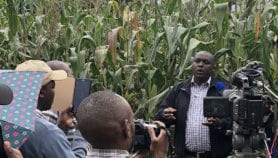By: T.V. Padma
Send to a friend
The details you provide on this page will not be used to send unsolicited email, and will not be sold to a 3rd party. See privacy policy.
T. V. Padma reports on Bhutan’s dilemma: how to reconcile conservation, economic development and happiness in a modern world.
Landlocked in the eastern Himalayas, the tiny country of Bhutan seems almost untouched by globalisation. Its icy peaks, deep green gorges, sparkling rivers and quaint buildings with multi-tiered sloping roofs strengthen the feeling of a country disconnected from the chaos of megacities and concrete jungles.
This pristine impression is partly due to Bhutan’s strong commitment to environmental preservation. Bhutan’s laws reserve 70 per cent of its land for ‘green’ cover, of which 60 per cent should be forests.
Bhutan is one of the few countries to employ the concept of gross national happiness — that social and economic development should promote happiness as its primary value.
Conservation of the environment and sustainable and equitable socioeconomic development are the two pillars of gross national happiness, which was declared more important than gross national product by Bhutan’s then king, Jigme Singye Wangchuk, in 1972.
But today, the country is facing change. Global warming is melting many of its glaciers, while its need for economic development and quest to export hydropower to neighbouring India may harm its fragile terrain. Bhutan is grappling with the dilemma of conservation versus development.
Development taking its toll
A growing population — up from 452,000 in 1984 to 750,000 in 2006 — as well as an increase in urbanisation and infrastructure is taking its toll on Bhutan’s environment.
Analysis by the National Environment Commission (NEC), an inter-ministerial body that develops policies on sustainable development, shows that about 25,000 acres of land have been used for development projects, while land and water pollution is an emerging environment problem in and around urban and industrial areas.
Development projects such as roads and power lines, NEC warns, could impact biodiversity by cutting through natural habitats and destablising fragile mountain slopes if they are not built in an environmentally sensitive manner.
Urban areas — along with some rural areas of southern and eastern Bhutan — are already witnessing localised deforestation, says the Bhutan office of the UN Development Programme (UNDP).
And a steady increase in vehicles — the number of cars rose by 11–17 per cent each year from 1985 to 2003 — is harming Bhutan’s air quality, once considered among the best in South Asia.
Bhutan’s development of hydropower plants could also impact the environment. Hydropower potential in Bhutan is estimated at over 30,000 megawatts, 16,000 megawatts of which could be provided safely by exploitable water resources like river run-offs. Only three per cent of this has been tapped, estimates the NEC, with domestic consumption in 2005 only 105 megawatts, and the country hopes to export some of this energy at a profit to neighbouring India.
Global warming at its door
Meanwhile, Bhutan is facing up to the impact of global warming. The country has a fragile mountain ecosystem, and climate change is a serious challenge to sustainable development and the livelihood of the Bhutanese people, says Nado Rinchen, deputy minister for environment.
 |
| Bhutan puts the happiness of its people before development |
| Credit: Flickr/mick y |
"Bhutan did not contribute to global warming, and yet we have to suffer the consequences today", he says.
Bhutan is one of the few countries in the world with the capacity to absorb greenhouse gases. NEC’s national greenhouse gas inventory — a record of emission and removal of gases that cause global warming, conducted in 2000 — shows that Bhutan is a net greenhouse gas absorber, largely because of its vast forest cover, limited industrialisation and use of hydropower as a clean energy source.
Despite this, Bhutan’s glaciers have been retreating over the last few decades at about 20–30 metres every year due to global warming, creating many moraine dammed lakes — lakes clogged by accumulated debris, which prevent meltwater from escaping — that are swelling rapidly.
Floods of these lakes — glacial lake outburst floods — are a serious concern. Bhutan has already experienced several of these floods and has 24 potentially dangerous glacial lakes, according to ICIMOD (the International Centre for Integrated Mountain Development) in Kathmandu, Nepal.
Bhutan’s National Adaptation Programme of Action, released in 2006, warns of changes in water flows, increased sedimentation of water reservoirs and networks, and reduced capacity of water catchment areas, all affecting hydropower electricity production.
Higher rainfall in areas without proper drainage systems can destabilise the soil, leading to landslides and more floods. Rinchen says Bhutan urgently needs to map its hazard zones as it is also prone to destructive landslides, mudslides and floods.
Bhutan has no proper weather or climate forecasting capabilities and its climate data and information is sparse, points out Doley Tshering, program officer for energy, environment and disaster, at UNDP’s Bhutan office.
Conservation at stake
NEC officials fear that climate change and the consequent rise in temperature and forest fires, along with changing rainfall patterns, could affect the country’s extensive forest cover, rich biodiversity and clean water resources.
Bhutan’s biodiversity is one of the richest in the world. It ranks among the top ten countries with the highest number of species per unit area, contains three of the World Wildlife Fund’s ecoregions of great biological wealth, and many of its plants have medicinal value.
   |
| Bhutan forest’s are rich in biodiversity |
| Credit: Flickr/Hoorob |
Unsurprisingly, conservation is central to Bhutan’s 1998 National Environment Strategy, which aims to balance economic development and environmental conservation.
The core of Bhutan’s conservation strategy is a system of national parks and protected areas that form 26 per cent of its land. An additional nine per cent is designated as ‘biological corridors’ or ‘wildlife highways’ that link protected areas to allow free movement of animals.
Yet much of Bhutan’s biological wealth remains unexplored by scientists. There is no baseline data to help scientists document and monitor changes in vegetation, wildlife and forests.
Some efforts have been initiated, with NEC due to sign an agreement with the United Nations Environment Programme (UNEP) this year to set up the Bhutan Integrated Biodiversity Information System to gather, interpret and document biodiversity information from both protected and other areas.
Putting the environment into development
Rinchen says Bhutan’s tenth national five-year plan, to be launched in 2008, will allocate ten per cent of all funds to programmes for environment activities, while the UNDP and UNEP are helping NEC to develop guidelines for incorporating environment into development plans and policies.
A National Environment Protection Act (NEPA), approved by Bhutan’s national assembly in June 2007, states the people and the government should "strive to consider and adopt its development policies and plans in harmony with the various environment principles".
The act states that to promote environment-friendly technologies, codes of practice and eco-labelling, the government will provide financial incentives for environment protection and compliance.
These will include tax incentives for environmental services, manufacture of environment-friendly products and reduced customs duties on environmentally friendly technologies.
Bhutan also aims to reduce the dependency of national park residents on national park resources, such as firewood, timber, roofing material and other forest products.
It hopes to reduce deforestation through use of alternate technologies include the introduction of electric cookers to substitute traditional fuel wood cookers and using corrugated iron sheets instead of wooden shingles for roofs.
Instead, the government will establish programmes to improve mule tracks and foot bridges, build community centres, supply solar panels and even offer scholarships to poor students so that they do not rely on forest produce for their livelihoods. Community-based ecotourism is also being promoted as an alternative means of livelihood.
Transboundary conservation projects are helping Bhutan come out of its isolation. ICIMOD’s Kanchenjunga project, involving Bhutan, India and Nepal, is helping to identify corridors needed to maintain biodiversity links and promote conservation-linked micro-enterprises and ecotourism in the region.
Bhutan is at a crossroads today, charting a course for its future. It plans to hold its first elections in 2008 and join the World Trade Organization. For many developing countries, this isolated Himalayan country could be an example of how to reconcile conservation and national happiness within the global trading framework.
This article is part of a Spotlight on Science in the Himalayas.
More on Capacity building


Script media release
Journalists offered ‘big break’ mentoring opportunity from Radio Nigeria
03/04/19












